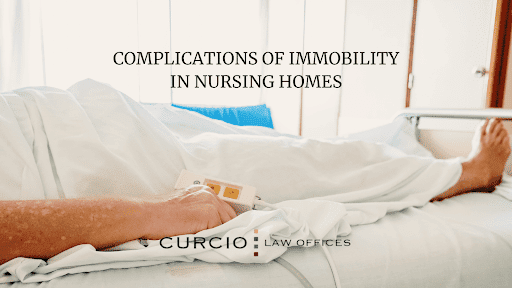Nursing homes and assisted living facilities should demonstrate an adequate level of care for their patients. Sadly, a large number of Chicago nursing home abuse and neglect cases involve those who suffer from injuries and complications of immobility. Immobile patients, unfortunately, have a greater chance of running into complications during their stay at a nursing home or assisted living facility.
Elderly patients who have been immobilized require more care than those who are able to get up and move around as they please. Nursing home staff are trained professionals who have the capability to deal with older patients who require bed rest.
If your loved one suffered from physical or psychological complications of immobility or other major complications in a nursing home, call to schedule a free consultation with an experienced Chicago nursing home abuse or neglect attorney at Curcio & Casciato.
Nursing Homes Cannot Leave an Immobile Patient Alone Without Risk
Chicago nursing homes and hospitals have been under the spotlight for their lack of care for their older patients, intensive care unit patients, and critically ill patients. The primarily affected victim often remains the immobile patient.
Bedridden patients, generally those immobilized from a debilitating disease, repeatedly require more routine care and attention. The nursing process should encourage the staff to perform skin assessment checks, muscle strength/muscle weakness tests, and frequent position changes. When we place our loved ones in a nursing home or assisted living facility and pay for their services, we hope that they’re being closely monitored and cared for by trained professionals.
Nursing Home Neglect in Chicago
Issues arise whenever immobile or critically ill patients are neglected in nursing homes. While many family members do understand that not every patient can be monitored 24/7, they still expect that their loved ones are checked on and moved at least once every 2 hours.
Many times, the nurses in both hospital and nursing home settings tend to do the bare minimum for immobile patients, even though they understand that doing so can lead to major complications. Many staff members stop their care after completing the absolutely necessary tasks, such as changing dressings and urine bags, checking blood pressure, bringing meals, etc. However, for patients who are unable to move on their own, this minimum effort isn’t enough.
Health issues arise when immobile patients become neglected in nursing homes, and the same could be said for hospitalized patients. Understandably, elderly patients who are immobile cannot be monitored every second of the day. However, being in the same laying or sitting position beyond 2 hours can be considered nursing home neglect for immobile patients.
Typically, critically ill patients require more medical attention and early mobilization exercises. The greater the severity of health conditions, the more care that the nursing home staff must provide for their recovery. Unfortunately, the systematic review of the nursing process is flawed.
Identifying the Complications of Immobility in Nursing Homes and Assisted Living Facilities

Complications of immobility in nursing homes and assisted living facilities contribute to health issues such as:
- Skin breakdown such as pressure ulcers or bedsores
- Muscle weakness and decreased muscle mass which can lead to foot drop
- Bone loss or loss of bone mass
- Joint pain
- Urinary incontinence, urinary retention, and urinary tract infections (UTI)
- Prolonged wound healing which leads to a longer hospital stay
- Blood clots
- Deep vein thrombosis
- Decreased respiratory vital capacity
- Orthostatic hypotension
- Gastrointestinal system issues such as lack of appetite and constipation from lack of movement
All of these health issues can add up to thousands of dollars in medical treatment, physical therapy, and so much more.
In many nursing home cases, complications of immobility are often preventable. Immobility and substantial bed rest can lead to life-altering physical and psychological complications. Nurses, care team members, and physical therapists must understand the importance of promoting client mobility and preventing immobility whenever possible.
Mental Effects of Prolonged Immobility
Not only can immobility take a huge toll on a patient’s physical health, but it can take a huge toll on the patient’s psychological health too. Let’s face it: laying in a bed all day, no matter how old you are, is incredibly depressing. Elderly people who suffer from critical illness in nursing homes may already be depressed. That’s why it’s so important for staff members to encourage mobility exercises and social interaction every day.
Bedridden older patients have high risks of depression, fatigue, anxiety, low self-esteem, loneliness, and hopelessness. Additionally, some studies claim that bedridden patients have a higher risk of developing dementia than mobile patients.
Cardiovascular and Respiratory Effects
Patients who suffer from immobility complications have an increased risk for several cardiovascular health issues.
Cardiovascular effects linked to immobility can include decreased blood circulation within the body from the lack of physical activity. When blood flow decreases, many side effects are likely to follow.
For example, organs fail to work as efficiently, especially the kidneys, because they filter both blood and urine. Decreased blood flow to the kidneys naturally results in decreased urine output. When this occurs, blood clots can form, which can become fatal for many bedridden patients.
Additional respiratory effects include the lack of blood flow to the lungs. Decreased blood flow naturally results in decreased oxygen in the body. Without proper care from nursing home staff, this can eventually lead to organ failure.
Immobility can also result in complications for the lungs, because without consistent movement, deep breathing isn’t happening. This can lead to increased respiratory infections and fluid buildup. For the elderly population, these issues can certainly be life threatening.
Urinary Tract Infections
UTIs are the most common type of infection encountered within the nursing home setting. A UTI occurs when harmful bacteria enters the urethra and travels up to the bladder, causing pain, increased urination, blood in the urine, etc. Without prompt treatment from nursing home staff, older patients can suffer a kidney infection, which could be fatal.
Maintaining adequate fluid intake happens to be among the primary risk factors for urinary infections in the elderly. This issue is often compounded by other complications of immobility, such as poor hygiene. Many bedridden patients end up sitting in their own waste for hours at a time. Additionally, many bedridden patients aren’t bathed often enough. Both of these issues promote a breeding ground for harmful bacteria in the urinary tract.
Two other risk factors for UTIs among immobile elderly patients are weakened immune systems and catheters. Many critically ill patients require urinary catheters because they can’t get up to use the bathroom by themselves. The longer a urinary catheter stays in, the more bacteria multiply inside the urinary tract. Additionally, many staff members in nursing homes and assisted living facilities could fail to properly insert the catheter, or fail to insert it in a hygienic manner, which are two other factors that can increase the risk of a UTI.
To prevent complications from a urinary tract infection, medical professionals must encourage fluids, improve patient hygiene, and be wary of urinary catheters.
Deep Vein Thrombosis
Deep vein thrombosis occurs when an elderly person has a blood clot in a deep vein. Deep vein thrombosis typically affects hospitalized older adults who are at least 60 years old. However, anyone with mobility issues can experience deep venous thrombosis. Initially, deep vein thromboses begin as a blood clot in just one of the legs, which can then travel to the individual’s lungs (pulmonary embolism). Staff members should recognize the DVT risk factor in patients in a prone position, and therefore provide them with sequential compression devices, which assist with blood circulation in the legs.
DVT or a pulmonary embolism can occur as soon as the first week after being admitted into a nursing home or assisted care facility. Nursing home staff may choose to leave critically ill patients in bed since allowing them to walk increases the chances of falling. Nursing home attendees may also leave immobile patients in bed for far too long due to their busy schedules.
Sadly, seniors can’t always fight for themselves due to mental and physical disabilities. So, if your loved one has an increased risk for health problems, such as immobility, try to visit them and ask questions as much as you can.
Pressure Ulcers
Pressure ulcers, otherwise known as bed sores, are most commonly found among immobile patients. Typically, bed sores are known to develop quickly on the patient’s skin, and should the pressure ulcer be left untreated, it can progress to a life-threatening infection.
Pressure Ulcer Prevention in Nursing Homes
Advanced stages of pressure ulcers are always preventable within the nursing home setting. Don’t allow staff to tell you otherwise. Your family or your loved one is paying for adequate care, and they have a right to receive that care.
Many nursing homes should have a charting-checklist or systematic review for patients with limited range of motion. The checklist should be updated before the two-hour mark, and nursing home staff should accomplish the following:
- Perform skin assessment: Staff must check the client’s skin for any signs of pressure ulcers, signs of deep vein thrombosis, wound healing, issues with sequential compression devices, etc.
- Encourage early rehabilitation or physical activity: Staff must encourage passive range of motion, changing positions, and motion exercises in order to build bone/muscle mass and increase blood flow.
Chicago Nursing Home Abuse Lawyer

Nursing home staff members must provide the best quality care to all their patients, especially those who struggle with critical illness and immobility. This means that a nursing home should be fully staffed, capable of tending to the patients’ needs and promoting healthy and happy lifestyles. However, what is not acceptable is neglect of the patients’ needs, which can ultimately lead to deep vein thrombosis, pulmonary embolism, urinary incontinence, urinary tract infections, skin breakdown and bedsores, decreased muscle strength, bowel dysfunction, and so much more.
If your loved one is suffering from the complications of immobility, you may have grounds to file an elder abuse lawsuit. Chicago nursing home abuse and neglect attorneys at Curcio & Casciato have what it takes to recover significant compensation on behalf of your loved one. Call 312-321-1111 today to schedule a free consultation.



